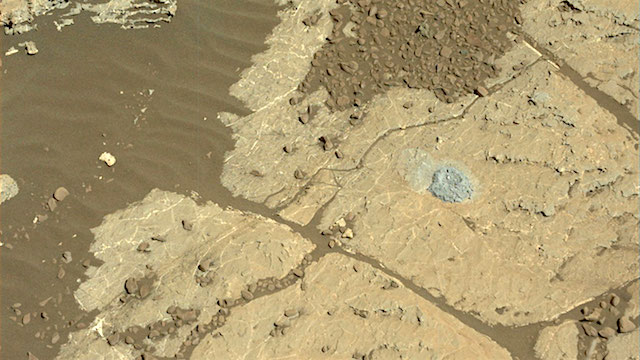 NASA’s Mars Curiosity rover has conducted the first test of a new drilling technique on the Red Planet since its drill stopped working reliably.
NASA’s Mars Curiosity rover has conducted the first test of a new drilling technique on the Red Planet since its drill stopped working reliably.
This early test produced a hole about a half-inch (1-centimeter) deep at a target called Lake Orcadie — not enough for a full scientific sample, but enough to validate that the new method works mechanically. This was just the first in what will be a series of tests to determine how well the new drill method can collect samples. If this drill had achieved sufficient depth to collect a sample, the team would have begun testing a new sample delivery process, ultimately delivering to instruments inside the rover. (…)
After months of effort, Curiosity’s engineering team was able to extend the drill all the way out past the stabilizers, but the motor issue persisted. The team posed a challenge for themselves: could they hack the space robot’s drill so that it didn’t require stabilizers?
Images of a new hole on upper Vera Rubin Ridge, Curiosity’s current location, suggest this “MacGyvering” is paying off. By leaving the drill in an extended position, engineers were able to practice this freehand drilling for months during testing here on Earth. This hole at Lake Orcadie provides the first insights into how this operation will work in the Martian environment.
If the previous method was like a drill press, holding the bit steady as it extends into a surface, it’s now more freehand. The NASA rover is using its entire arm to push the drill forward, re-centering itself while taking measurements with a force sensor. That sensor was originally included to stop the rover’s arm if it received a high-force jolt. It now offers Curiosity a vital sense of touch, preventing the drill bit from drifting sideways too much and getting stuck in rock.
“We’re now drilling on Mars more like the way you do at home,” said Steven Lee, deputyprojectmanager at NASA’s Jet Propulsion Laboratory, Pasadena, California. “Humans are pretty good at re-centering the drill, almost without thinking about it. Programming Curiosity to do this by itself was challenging — especially when it wasn’t designed to do that.” [More at link]








